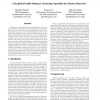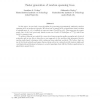1282 search results - page 82 / 257 » Algorithms for Large, Sparse Network Alignment Problems |
BMCBI
2004
13 years 10 months ago
2004
Background: Hidden Markov Models (HMMs) have proven very useful in computational biology for such applications as sequence pattern matching, gene-finding, and structure prediction...
ICPP
2000
IEEE
14 years 2 months ago
2000
IEEE
Clustering is a data mining problem which finds dense regions in a sparse multi-dimensional data set. The attribute values and ranges of these regions characterize the clusters. ...
ICANN
2005
Springer
14 years 3 months ago
2005
Springer
Although Support Vector Machines (SVMs) have been successfully applied to solve a large number of classification and regression problems, they suffer from the catastrophic forgetti...
JVA
2006
IEEE
14 years 4 months ago
2006
IEEE
Grid computing is a form of distributed computing that involves coordinating and sharing computing, application, data storage or network resources across dynamic and geographicall...
FOCS
2009
IEEE
14 years 5 months ago
2009
IEEE
In this paper, we set forth a new algorithm for generating approximately uniformly random spanning trees in undirected graphs. We show how to sample from a distribution that is wi...


